
Follen Church is a historic Unitarian Universalist congregation located at 755 Massachusetts Avenue in Lexington, Massachusetts, United States.

The Mount Zion AME Church is a historic church in Jacksonville, Florida, United States. It is located at 201 East Beaver Street. On December 30, 1992, it was added to the U.S. National Register of Historic Places. The "AME" is an abbreviation of African Methodist Episcopal, the religious denomination.
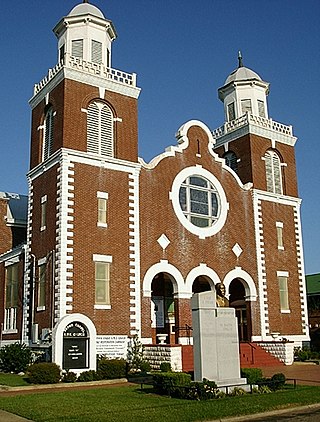
Brown Chapel A.M.E. Church is a church at 410 Martin Luther King Jr. Boulevard in Selma, Alabama, United States. This church was a starting point for the Selma to Montgomery marches in 1965 and, as the meeting place and offices of the Southern Christian Leadership Conference (SCLC) during the Selma Movement, played a major role in the events that led to the adoption of the Voting Rights Act of 1965. The nation's reaction to Selma's "Bloody Sunday" march is widely credited with making the passage of the Voting Rights Act politically viable in the United States Congress.
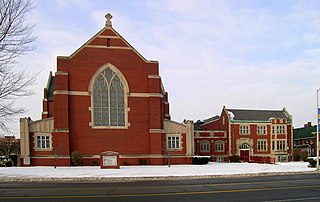
The St. John's Christian Methodist Episcopal Church is a church located in Detroit, Michigan. It was built as the North Woodward Congregational Church, listed on the National Register of Historic Places in 1982, and designated a Michigan State Historic Site in 1998.
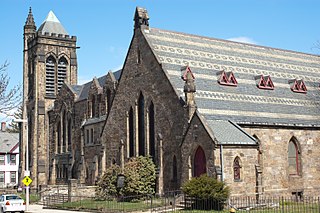
The Eliot Congregational Church is a historic Congregational church at 56 Dale Street, at the corner of Walnut Avenue in the Roxbury neighborhood of Boston, Massachusetts.

Bethelem Lutheran Church is an historic stone Lutheran church located at 412 South White Street in Round Top, Texas.

The First Christian Church is a historic Disciples of Christ church located at 101 North Tenth Street in Columbia, Missouri. It was designed by T.N. Bell of Chicago, Illinois and built in 1893. It has a Richardsonian Romanesque style Sanctuary that includes a square bell tower, horizontal massing with contrasting high gables, round arches, heavy and highly textured stone work, and voussoir arches. The Education Building was designed by Eugene Groves and added in 1929. This is the second church building to stand at this site. The building is still a functioning church today.

St. Paul's Church is a historic Episcopal church in Lynchburg, Virginia, United States.

All Saints Church Pawleys Island is a historic church complex and national historic district located in Pawleys Island, Georgetown County, South Carolina. The district encompasses three contributing buildings and one contributing site—the sanctuary, cemetery, rectory, and chapel. In 2004, it left the Episcopal Church to join the Diocese of the Carolinas, now part of the Anglican Church in North America, a denomination within the Anglican realignment movement.
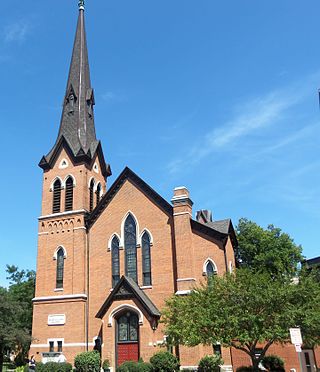
Congregational United Church of Christ is located in the downtown area of Iowa City, Iowa, United States near the campus of the University of Iowa. The congregation was organized in 1856 and the church building was listed on the National Register of Historic Places in 1973. In 2004 it was included as a contributing property in the Jefferson Street Historic District.

The former Mizpah Presbyterian Church is a building in southeast Portland, Oregon.

The First Presbyterian Church is a historic church at 213 Whittington Avenue in Hot Springs, Arkansas. It is a large stone building, designed by Charles L. Thompson in Late Gothic Revival style and built in 1907. It has a square tower with pronounced buttressing at the corners set on the right side of its front facade, and a lower tower at the left side, with a gabled entry section at the center. The entrance is set in a broad lancet-arched opening, and is topped in the gable by a three-part stained glass window. The main sanctuary space is set perpendicular to the main facade, with a large stained glass window set in a recessed round-arch panel at the end. An entrance into the tunnels underneath hot springs is also located here.
Loucks Grove Church is a historic church in Greenfield, Iowa, United States that is.National Register of Historic Places (NRHP).

The First United Methodist Church is a historic church building in Fordyce, Arkansas. The two story brick building was designed by John Parks Almand and built in 1925. The Arts and Crafts style building presents a long facade to East 4th Street, with its main entry separating the sanctuary to the right and a wing of offices and Sunday School classrooms to the left. It was the second church for a congregation established c. 1883; the first was destroyed by fire in 1922.

Kings Highway Christian Church is a historic Disciples of Christ church in Shreveport, Louisiana. Kings Highway Christian Church was established on May 20, 1923. Kings Highway Christian Church is also nearby C.E. Byrd High School.

The First United Methodist Church is a historic church building at 204 S. Main in Hamburg, Arkansas. The brick Gothic Revival building was built in 1910 for Hamburg's first organized congregation, founded in 1850, which had previously met in a wood-frame building on the same site. It was designed by the Nolley Brothers, who owned a local brickyard, and was based on Gothic Revival designs that one of them had observed at the St. Louis World's Fair.

The First Presbyterian Church is a historic church on AR 79B in Fordyce, Arkansas. The congregation was organized in 1883, and was the first in the city of Fordyce. This building is its third sanctuary, built in 1912 to a design by Tennessee architect Reuben Harrison Hunt. It is a modest example of Gothic Revival styling executed in buff brick, with three towers.

Holly Grove Presbyterian Church is a historic church at 244 East 2nd Street in Holly Grove, Arkansas. It is a single-story wood-frame building, with a gable-roofed rectangular sanctuary, a square tower off to one side, and a Sunday School addition to the rear. The exterior, originally clad in board-and-batten siding, is now finished in metal siding that closely resembles a c. 1900 residing. It exhibits a combination of Greek Revival and Gothic Revival features. It was built in 1881 for a congregation established in 1839, and was its second sanctuary, replacing one destroyed by fire in 1871.
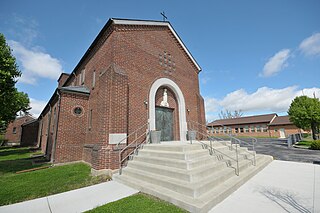
The St. Mary's Catholic Church is a historic church building at 301 W. Highland in Paragould, Arkansas. It was designed early in the career of Charles Eames, and is one of only two known church designs of his in Arkansas, the other being St. Mary's, Helena. Built in 1935, it is stylistically a modern reinterpretation of Romanesque Revival architecture. The congregation was organized in 1883; this is its second sanctuary.
St. Luke's Episcopal Church, formerly known as Hope Episcopal Church, is a historic church building located in Fort Madison, Iowa, United States. It is a parish church of the Episcopal Diocese of Iowa, and it is a contributing property in the Park-to-Park Residential Historic District listed on the National Register of Historic Places.




















